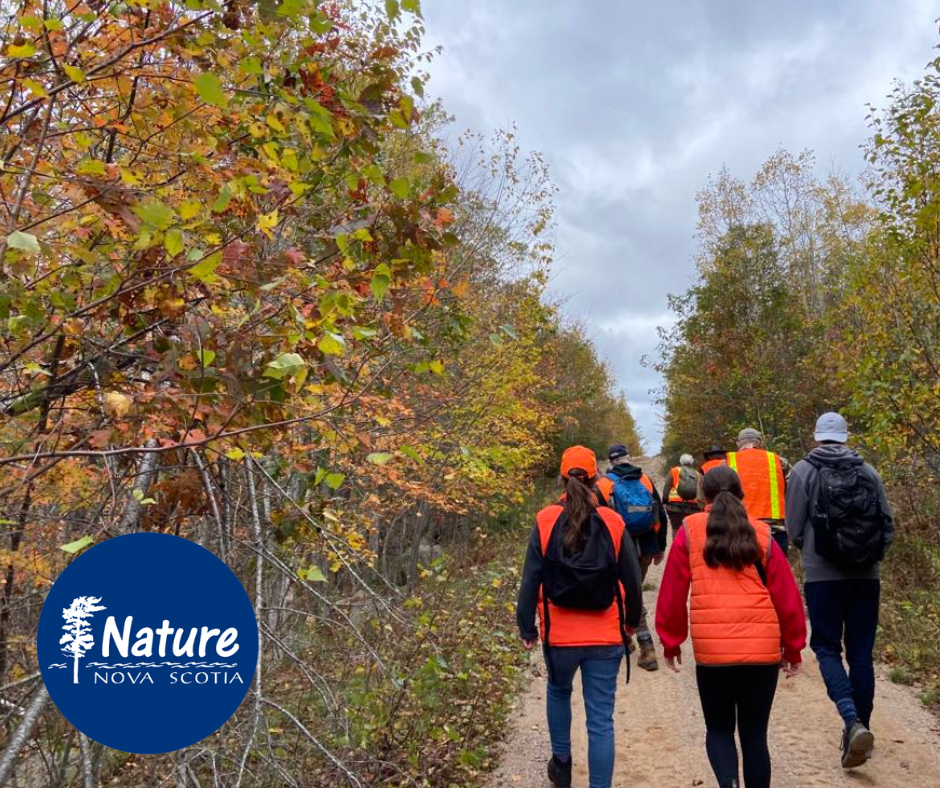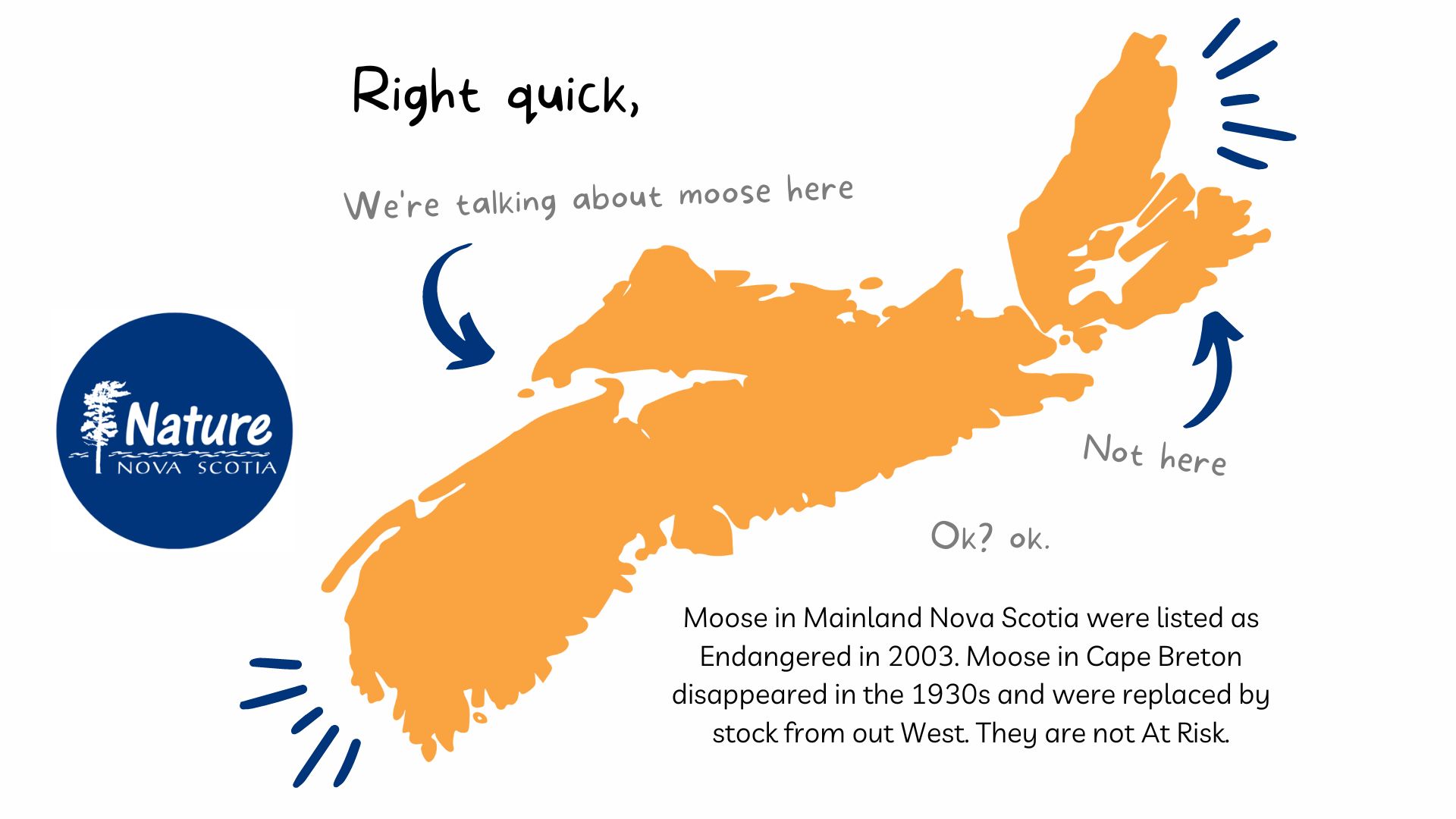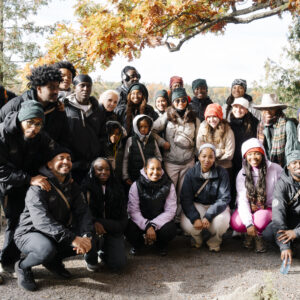Saving the Mainland Moose of Nova Scotia
Thank you to our Nature Network partner, Nature Nova Scotia, for sharing this month’s blog.
The moose, a symbol of the Canadian wilderness, can be found roaming through forests and wetlands from British Columbia to Newfoundland and Labrador. However, in one small Atlantic province, Nova Scotia, the moose (Mi’kmaq: Tia’m) is facing a dire situation.
While moose are abundant in the wilds and tourist shops of Canada, the Mainland Moose (Alces alces americana) population is on the brink of extinction. Despite being officially recognized as endangered since 2003, the population has not recovered. This population decline from 15,000 individuals to an estimated 700 in 2023 has been ongoing since the early or mid-1800s, when European settlement expanded in the Maritimes, adding pressure to populations already threatened by subsistence hunting and the fur trade.
Confusion with Cape Breton
So why haven’t you heard of the Mainland Moose?
The confusion and lack of knowledge surrounding the Mainland Moose are compounded by the presence of the Cape Breton moose (Alces alces andersoni). The current population in Cape Breton started from the introduction of 18 moose from Alberta in the late 1940s. (The original population of moose in Cape Breton had been wiped out in the late 1800s to early 1900s alongside the caribou—another story for another time.) This confusion makes tracking and conservation efforts in Nova Scotia significantly different from other parts of Canada.
Tracking Trouble
Tracking the elusive Mainland Moose is challenging. With only an estimated 700 individuals remaining, they are difficult to find and study.
Moose are browsers not grazers, munching up to 27 kilograms of twigs, leaves, buds or aquatic plants daily. One of the ways scientists track moose is through browse studies (recognizing the jagged edges of twigs torn by moose and counting them using GPS). Another common way to track moose is through pellet counts. In Nova Scotia, we have two species in the deer family—the white-tailed deer and the Mainland Moose. To distinguish their pellets, we like to use the analogy of chocolate-covered almonds (moose) versus chocolate-covered raisins (deer).
Aside from scat tracking and twig examination, spotting a moose track and reporting it to officials can be a telling technique. Bob Bancroft, President of Nature Nova Scotia, likes to say that the only thing you can confuse a moose track with is a cow track. Truth be told, cows and moose don’t often cross paths, although it’s not unheard of. Moose tend to enjoy deep mature forests, while cows tend to frequent fenced-in fields and barns.
The secretive nature of the moose, combined with the threat of poaching, makes their conservation even more difficult.
Population Declines and Threats
The Mainland Moose faces numerous threats.
Mainland Moose have few natural predators. The native Eastern Wolf was hunted to extinction by the mid-1800s. The newly established coyote, or coywolf, is capable of being a significant predator. Black Bears may occasionally take a young moose, but predation does not seem to be a limiting factor in moose population trends in Nova Scotia today. The Mainland Moose has not recovered, despite a complete ban on legal hunting, minimal suspected predation, and probably high twinning rates and calf survival.
Possible explanations for this stalled recovery include reduced habitat availability and weakened connectivity. Nova Scotia is surrounded by water except for the Chignecto Isthmus, a critical corridor highly fragmented by roads, forestry, and development. This isthmus serves as the province’s only connection to the rest of Canada. For animals like moose moving between New Brunswick and Nova Scotia, this can be extremely dangerous and difficult due to the presence of roads, railways, and other human developments.
Additionally, the moose population may be affected by infection from Parelaphostrongylus tenuis, a brainworm disease carried by introduced White-tailed Deer. Other factors such as cadmium bioaccumulation and poaching may also contribute to the challenges faced by the moose population.
Nevertheless, Nature Nova Scotia persists in advocating for their protection.
Helping the Mainland Moose
It is essential to improve awareness and education about the plight of the Mainland Moose. Given the goal of increasing the population to 5,000 individuals (including 500 breeding individuals) over the next 20 years, urgent action is needed. With Nova Scotia being clear-cut every 30-40 years, mass clear-cutting threatens not only the moose but also the entire forest ecosystem. As the second smallest province in Canada, the results of this practice are alarming. Nature Nova Scotia staff are often asked, “Why can’t we just bring more moose here?” While this is an endearing suggestion, adding new moose to a struggling population does not fix the issues they face.
Join us in reporting sightings, fighting against clear-cutting, and volunteering for research and conservation efforts. Together, we can help save this iconic Canadian species from extinction.

Nature Nova Scotia is a federation of natural history societies and other environmental groups in Nova Scotia. As a registered charity, Nature Nova Scotia operates to support networking, research, education, and advocacy initiatives for nature.
Want to help Canadian species like the Mainland Moose and more? Be a voice for Nature and send a personal letter to the Prime Minister, Environment Minister, and the Oceans Minister demanding for wildlife protection.




